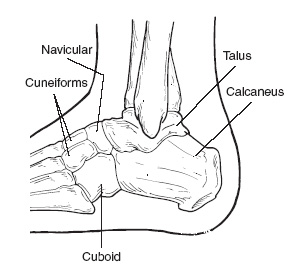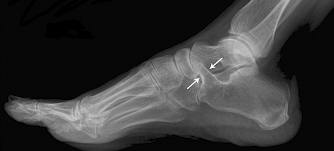Connect With Us
Tarsal Coalition
What is a Tarsal Coalition?
 A tarsal coalition is an abnormal connection that develops between two bones in the back of your foot (the tarsal bones). The tarsal bones are the talus, calcaneus, navicular, cuneiforms and the cuboid.
A tarsal coalition is an abnormal connection that develops between two bones in the back of your foot (the tarsal bones). The tarsal bones are the talus, calcaneus, navicular, cuneiforms and the cuboid.
These bones work together to provide the motion necessary for normal foot function.
This abnormal connection—which can be composed of bone, cartilage, or fibrous tissue—may lead to limited or a complete lack of motion and pain in one or both feet. Pain may occur at the affected joint or at surrounding joints as well.
What Causes a Tarsal Coalition?
Tarsal coalition is a condition most often caused by a hereditary defect that occurs during fetal development and results in the individual bones not forming properly. Less common causes of tarsal coalition include infection, arthritis, or previous trauma or injury in the area.
A tarsal coalition is difficult to identify until a child’s bones begin to mature. Diagnosis includes obtaining information about the duration and development of the symptoms as well as a thorough examination of the foot and ankle. The findings of the exam will differ according to the severity and location of the coalition.
 In addition to examining the foot, the surgeon will order x-rays. Additional advanced imaging—such as CT or MRI scan—may also be needed to evaluate the coalition.
In addition to examining the foot, the surgeon will order x-rays. Additional advanced imaging—such as CT or MRI scan—may also be needed to evaluate the coalition.
What are the Signs and Symptoms of a Tarsal Coalition?
Symptoms typically don’t occur until the bone in the foot start to mature. This can happen anywhere between the ages of 9-16. Sometimes there are no symptoms during childhood and symptoms may not develop at all or until later in life.
The signs and symptoms may include one or all of the following:
- Pain when walking or standing (pain may be mild to severe)
- Tired or fatigued legs
- Muscle spasms in the legs
- Flatfoot (in one or both feet)
- Walking with a limp
- Stiffness of the foot or ankle
- Aching sensation deep in the foot near the ankle or arch
How is Tarsal Coalition Treated?
Nonsurgical treatments, such as corrective shoes or custom orthotics, physical therapy, and anti-inflammatory medication, are the first courses of action. Note: Please consult your physician before taking any medications. Surgery is sometimes performed in severe cases to allow for more normal motion between the bones or to fuse the affected joint or surrounding joints.
